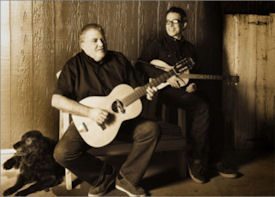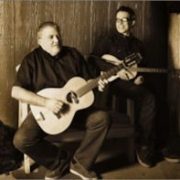Los Lobos Retro
LOS LOBOS RETROSPECTIVE:
Long on Song/Short on Story

Over 35 years ago, Garfield High School students David Hidalgo and Louie Perez began composing songs together. As Perez expressed it to the adoring audience at Torrance Cultural Art Center on Sunday, January 11, "It all started in 1970 when I went over to David's house and stayed about a year." Their collaboration evolved into Los Lobos, the Grammy-winning band from East L.A. that has traveled the world with its unique blend of Chicano rock, Tejano music, rock en Espanol, and Mexican roots music.
So, when a small entry in South Bay's Beach Reporter announced David Hidalgo and Louie Perez of Los Lobos: Stories and Songs at Torrance Cultural Arts Center, it seemed like a rare opportunity to learn how the pair's experiences have driven the development of this home-grown musical phenomenon.
The evening did not deliver all it promised. Hidalgo and Perez offered an engaging musical potpourri from various phases of the band's development plus some previously unreleased material worth hearing. They gave brief prefaces to the songs they performed. But there was no extended sharing that you could call a story.
Without the storytelling to give insight into the life experiences that inspired their creative process, it would have helped if the songs they performed at least had been arranged chronologically. Instead, we were jumping around from the eighties to the nineties, then back to the eighties, and over to our present decade with their successful 2006 release The Town and the City.
But Hidalgo and Perez redeemed themselves with the songs. They performed the first song they composed about the immigrant experience A Matter of Time. The piece is a touching slice of life: a man who is leaving his wife and baby to work in El Norte reassures his wife that they will be together again. As the lyrics express hope and confidence, the music moved back and forth from major to minor chords as if to signal the fear and uncertainty that accompany that hope. Similarly, The Valley is a plaintive yet hopeful evocation of farm workers sacrificing for their children to put bread on the table. It included a striking passage with Perez playing a passionate tremolo on the mandolin.
A rousing country-western number proved that the Los Lobos founders have the musical chops needed for that idiom. Another number strongly reminiscent of a Cajun two-step was thoroughly engaging. A mesmerizing, percussion-heavy piece called Chinese Surprise intrigued this listener, but there was no explanation of title or the number's origins.
The most rousing music came with a song from their 1988 album La Pistola y El Corazon in which they drew directly from Mexican roots music. Interestingly, while the album sold poorly, it earned the group a Grammy for Best Mexican-American Performance in 1989.
David Hidalgo, gray-haired and hefty at 54, showed himself to be a powerful and passionate vocalist, moving adeptly from guitar to fiddle or accordion. The slightly built, dark-haired Perez, 55, took a more gentle approach to the vocals and displayed excellent musicianship on the guitar and drums. When, during the Q and A at the end of the show, an audience member suggested that Hidalgo focuses on the musical composition and Perez is primarily a lyricist, Perez vigorously rejected that notion. He said their process of give and take in composing involved them both in the composition of music and lyrics.
The spicy moments of the evening originated mainly from Richard Montoya of Culture Clash, who introduced the pair at the start and moderated a Q and A. He started out by grimly announcing, "There will be no yelling out for (them to sing) La Bamba." He said four bikers were waiting in the lobby to deal with those violating this edict. Montoya also made a few cracks about never seeing this many Latinos in Torrance before.
The Q and A revealed the band's major musical influences to be Elvis and Duane Eddy, as well as the Louis Prima, mambo, and Mexican folk and pop records their parents used to play. Intriguing tidbits emerged such as family get-togethers where Hidalgo said he "turned into a cholo as the night went on" and the Bus RTD#47 that he took between East and West Los Angeles for many years. Most audience members prefaced their questions with heartfelt expressions of appreciation, many having experienced the phases of their adulthood to the soundtrack of the evolving band, Los Lobos.
The Torrance performance was the third and final stop on a mini-tour that included Napa and San Diego. Hidalgo and Perez avowed that it was an opportunity to perform several numbers they had not played in public for many years and a chance to share some unpublished material. They repeatedly pitched the "souvenir" available for sale in the lobby, a CD titled Unreleased Songs and Rare Recordings. The show was also a family affair with the pair's spouses, children, and grandchildren sitting in the audience and the stage wings. One had the sense of participating in a celebration of artistic success and community survival.
At a time when prominent Angelinos associated with East Los Angeles are pushing for East L.A. to become a bona fide city, Los Lobos carries the history of the community in its music. You could debate whether Richard Montoya was lost in hyperbole when he compared the band's "American songbook" to the contribution of Simon and Garfunkel. But there is no question that Los Lobos has created a unique soundtrack of East L.A. and the gritty stuff of the life of its people.
Audrey Coleman is a writer, educator, and passionate explorer of world music and culture. Research for the above article came from classes she took in UCLA's Department of Ethnomusicology, from forays into The Rough Guide to World Music, Volume 2 (Rough Guides Limited, London, Penguin Books, 2000), and from obsessive listening and web-surfing on the subject.













